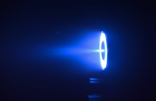Ultrahigh Current Density Hall Thruster
TECHNOLOGY NUMBER: 2023-401

OVERVIEW
High-current density Hall thruster for advanced propulsion applications
- Increases thrust density and efficiency by operating at ten times higher current density
- Useful for space exploration, satellite propulsion, deep-space missions, and advanced aerospace technologies
BACKGROUND
Hall thrusters have been a cornerstone of electric propulsion systems used in satellite positioning and deep-space missions. These devices generate thrust by ionizing a propellant and accelerating the ions using a magnetic field. Historically, enhancing the current density of Hall thrusters has been limited by thermal and electrical constraints, restricting their thrust density and efficiency. As space missions become more ambitious, there is a demand for propulsion systems that deliver higher thrust while maintaining efficiency. Current Hall thrusters struggle to meet these requirements, highlighting the need for innovations to achieve higher performance without compromising system stability or longevity.
INNOVATION
Researchers have created a novel approach to Hall thruster technology that operates at ten times the current density of state-of-the-art devices, dramatically increasing thrust density and enabling efficient operation on non-traditional propellants. The key features of this breakthrough remain proprietary but have been substantiated through performance metrics shared in a recent conference proceeding. By amplifying current density, the new Hall thruster offers a thrust increase, making it suitable for demanding applications such as space exploration, satellite propulsion, and deep-space missions. Potential real-world applications include enhancing satellite maneuverability, enabling faster interplanetary travel, and supporting the propulsion needs of next-generation aerospace technologies.
ADDITIONAL INFORMATION
REFERENCES:
Leanne L. Su, Parker J. Roberts, Tate Gill, William Hurley, Thomas A. Marks, Christopher L. Sercel, Madison Allen, Collin B. Whittaker, Matthew Byrne, Zachariah Brown, Eric Viges and Benjamin Jorns. "Operation and Performance of a Magnetically Shielded Hall Thruster at Ultrahigh Current Densities on Xenon and Krypton," AIAA 2023-0842. AIAA SCITECH 2023 Forum. January 2023.